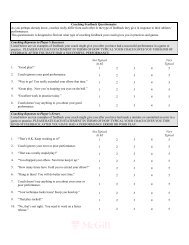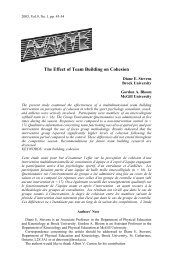International Journal of Sport Psychology
International Journal of Sport Psychology
International Journal of Sport Psychology
You also want an ePaper? Increase the reach of your titles
YUMPU automatically turns print PDFs into web optimized ePapers that Google loves.
PROCEDURES<br />
Following approval from the university behavioral research ethics board, a list <strong>of</strong> provincial<br />
sport organizations in Saskatchewan was obtained from the Sask <strong>Sport</strong> website<br />
(www.sasksport.sk.ca) and all were contacted. Upon the approval from each sport organization<br />
and coaching staff, the first author or a research assistant attended a practice session to<br />
explain the purposes and procedures <strong>of</strong> the study. Consent and assent forms were distributed<br />
and taken home to be completed by both the athletes and their parent or guardian. Forms<br />
were returned, generally within a week, to the coaching staff. A member <strong>of</strong> the research team<br />
then returned to administer the questionnaire and was present to answer questions. Participants<br />
first completed demographic questions. They then completed an open-ended section in<br />
which they were asked to describe situations that made them uncomfortable or nervous, any<br />
overall body concerns, and how they dealt with those concerns. The purpose <strong>of</strong> this section<br />
was to act as a cue to facilitate thinking about issues relevant to the study, and was not used in<br />
the analyses. The remaining measures were then completed in the following order: state SPA,<br />
coping, and trait SPA. Responses were anonymous, and questionnaires took 15-45 minutes to<br />
complete.<br />
MEASURES<br />
Demographics. Participants were asked to indicate gender, age, height, weight, sport<br />
involvement, and corresponding team/club names and level (club, provincial, national, and<br />
/or international).<br />
State SPA. The state SPA measure was adapted from Kowalski et al. (2006) who developed<br />
the measure for use with an adolescent female non-sport sample. Athletes first described<br />
a situation in sport where they felt uncomfortable or nervous because their body was seen or<br />
evaluated by other people. Specifically, they were asked to "Please describe the situation that<br />
made you feel the most uncomfortable in the past year." Second, they described why the situation<br />
made them feel uncomfortable or nervous. Third, they rated their level <strong>of</strong> state SPA on<br />
a visual analogue scale in reference to how uncomfortable or nervous they were in the situation,<br />
ranging from 0 (not uncomfortable or nervous) to 100 (extremely uncomfortable or nervous).<br />
Convergent validity was supported by Kowalski and colleagues (2006) via a significant<br />
relationship with trait SPA (r = .44, p < .05). All situations reported by the adolescents were<br />
double-checked and confirmed as body evaluation scenarios.<br />
Coping strategies, functions, and effectiveness. Open-ended questions were utilized to<br />
gather information on the coping strategies athletes used to cope with the experience <strong>of</strong> SPA<br />
in the self-identified situation described in the state SPA measure. Participants were provided<br />
with the following instructions, "Now we are interested in the specific ways to deal with the<br />
situation that you described". They were provided instructions to fill in only as many strategies<br />
as they tried, regardless <strong>of</strong> whether or not the strategy was successful. On each page, if<br />
applicable, they completed their response to the follow item stem, "To manage the uncomfortable<br />
or nervous situation, I: _______". To assess function, participants indicated (yes/no)<br />
whether each strategy was (1) an attempt to change the situation (problem-focused); (2)<br />
whether it helped them to manage or control their feelings (emotion-focused); and (3)<br />
whether it was an attempt to physically or mentally avoid the situation (avoidance). They then<br />
374




